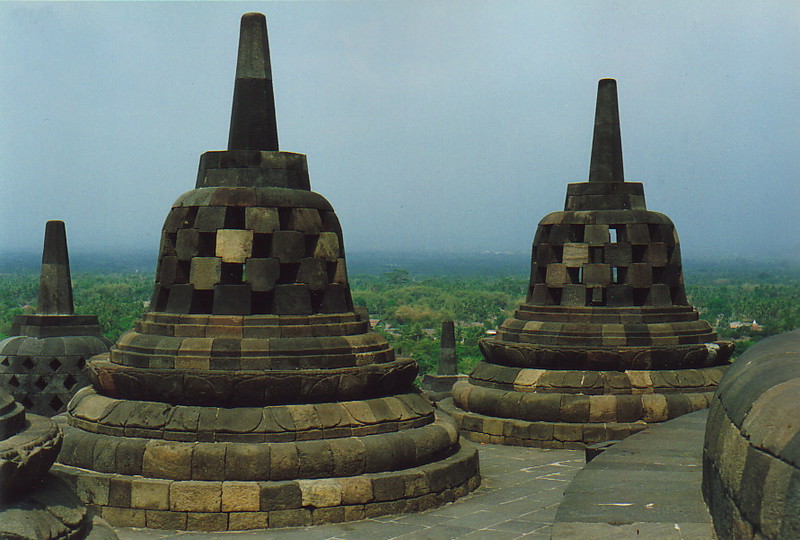
The temple complex of Borobudur, about 30km northwest of Yogyakarta, contains the biggest single Buddhist temple in the world; there are larger complexes elsewhere, notably in Cambodia, but none of the individual temples themselves are as big as the one at Borobudur. And it's absolutely massive; covering the top of a hill in a square that's about 120m by 120m, this huge construction is built in a series of layers, getting progressively smaller as you get to the top; if you think of a square-bottomed pyramid that's made up of thick layers, you're not far off. And if the size doesn't impress you, around each layer is an open corridor, smothered with sculptures and stone reliefs absolutely everywhere you look. It's stunning.

There are three layers in the temple, representing the three divisions in Buddhist cosmology, namely the world of desires, the transitional sphere, and the sphere of perfection and enlightenment. The idea of Borobudur is that walking through the corridors and layers represents the journey through life, from the world we live in through to enlightenment, and students of Buddhism would walk through the monument as a way of appreciating the philosophy behind their religion. In all honesty, unless you're a Buddhist expert it's going be less of a spiritual journey and more of a cultural one, and the subjects of the thousands of reliefs and sculptures will mean precious little... but in the end, that matters little.

For it's the scale of this whole exercise that's astounding. The reliefs alone would stretch for three kilometres if laid end to end. There are 1460 individual narrative reliefs and 1212 decorative reliefs. The first layer is covered up by stone walls; they're not sure why they were covered, but it's an indication of how Borobudur wasn't created for show, but for spiritual purposes. The second layer is dominated by 504 statues of Buddha, in various hand poses. The third layer, which is circular rather than rectangular and creates a pleasing aspect at the top of the structure, contains 72 lattice dagobs (stone stupa-shaped constructions that look like large hand-bells), each containing a Buddha statue inside the lattice.
Everywhere you look are more sculptures, statues, stories and dagobs, and you can walk around the whole complex for a considerable time without repeating yourself. The sheer labour involved in building Borobudur is amazing, but little is known about the actual construction, rather like the Pyramids and Stonehenge.

So, Borobudur is astounding; indeed, it's worth visiting Java for Borobudur alone. Having read about Buddhism and its history and practice, it was good to see some concrete examples of what the Buddhists achieved, architecturally speaking. The most famous Buddhist monuments might be in Cambodia, Thailand and India, but Borobudur is still unique, and the fact that it is a stone's throw from the amazing Hindu complex of Prambanan is simply icing on the cake.
Even if you're not interested in Buddhism or the history of religion in Indonesia, Borobudur is still an amazingly atmospheric place to explore. It's even more incredible to think that until the start of the 20th century, the whole complex was in complete ruins, buried under rainforest and the detritus of volcanic eruptions. Between 1907 and 1911 the Dutch ran a restoration project, but it wasn't until the late 1970s and early 1980s that the complex was fully rebuilt by UNESCO, leading to World Heritage status in 1991. Hats off to the archaeologists who pieced the puzzle back together; it was well worth the effort.